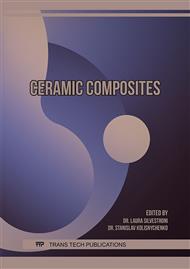[1]
Lyalyakin, V.P., Litovchenko., N.N., Sablukov, A.S., Denisov, V.I., & Sokovtseva, V.N. (2006). The physical nature and conditions of adhesion of particles of a metal powder to a substrate during thermal spraying. Technology of metals, (5), 36-44.
Google Scholar
[2]
Bolshakov, V.I. et al. (2011). Ceramic composite materials for work at high temperatures. Scientific works Construction, materials science, mechanical engineering, (58), 351-352.
Google Scholar
[3]
Lakiza, S. M., Tyschenko, J. S., & Lopato, L. M. (2011). Phase diagram of the Al2O3–HfO2–Y2O3 system. Journal of the European Ceramic Society, 31(7), 1285-1291. https://doi.org/10.1016/j.jeurceramsoc.2010.04.041.
DOI: 10.1016/j.jeurceramsoc.2010.04.041
Google Scholar
[4]
Friedman, A.Kh., & Mikus, E.B. (2001). Coatings for refractory alloys for short-term service at high temperatures. FriedmanProtective coatings on metals, Kyiv.
Google Scholar
[5]
Stubican, V.S., & Hellman, J.R. (1981). Phase Equilibria in some Zirconia System. Science and Technology of Zirconia, (3), 25.
Google Scholar
[6]
Vashkevich, F.F., Spilnik, A.Ya., & Esipova, E.S. (2010). Thermal technical properties of protective coatings obtained by thermal spraying. Construction, materials science, engineering. Sat. scientific labor, (55), 54-58.
Google Scholar
[7]
Loshchinin, Yu.V., Razmakhov, M.G., Pakhomkin, S.I., & Lutsenko, A N. (2019). The influence of the composition and technology of applying multilayer heat-protective coatings made by gas spraying on thermal conductivity. Proceedings of VIAM, 6(78), 96-103.
Google Scholar
[8]
Chubarov, D.A., & Budinovsky, S.A. (2015). The choice of ceramic material for heat-protective coatings of aircraft turbine blades for operating temperatures up to 1400ºС. Transactions of VIAM, electron. scientific - tech. Journal, (4).
Google Scholar
[9]
Loshchinin, Y. V., Budinovsky, S. A., & Razmakhov, M. G. (2018). heat conductivity of heat-protective coatings ZRO2–Y2O3 alloyed by rem oxides obtained by magnetronny application. Aviation Materials and Technologies», (3), 42-49. https://doi.org/10.18577/2071-9140-2018-0-3-42-49.
DOI: 10.18577/2071-9140-2018-0-3-42-49
Google Scholar
[10]
Matveev, P.V., &Budinovsky, S.A. (2014). The study of the properties of protective heat-resistant coatings for intermetallic nickel alloys type VKNA for operating temperatures up to 1300ºС. Aviation materials and technologies, 3(52). 22-26.
DOI: 10.18577/2071-9140-2014-0-3-22-26
Google Scholar
[11]
Matveev, P.V., Budinovsky, S.A., & Chubarov. D.A. (2014). The technology for producing ion-plasma heat-resistant sublayers with a high aluminum content for promising TZP. Aviation materials and technologies, (5), 56-60.
Google Scholar



